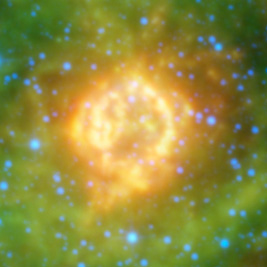 |
|
A storm of stars is brewing in the Trifid nebula, as seen in this view from NASA's Wide-field Infrared Survey Explorer, or WISE.
More |
|
 |
|
NASA's NEOWISE mission captured this series of pictures of Comet Pan-STARRS -- as it swept across our skies in May 2014
More |
 |
|
A witch appears to be screaming out into space in this new infrared portrait of the Witch Head nebula.
More |
|
 |
|
A dying star, called the Helix nebula, is shown surrounded by the tracks of asteroids in an image captured by NASA's WISE.
More |
 |
|
NASA's Wide-field Infrared Survey Explorer, or WISE, is helping to find the rarest and largest of galaxy groupings in the universe.
More |
|
 |
|
The Great Nebula in Orion is featured in this sweeping image from NASA’s Wide-field Infrared Survey Explorer, or WISE.
More
|
 |
|
WISE's mission has led to a bonanza of newfound supermassive black holes and extreme galaxies called hot DOGs.
More |
|
 |
|
A dying star is throwing a cosmic tantrum in this combined image from NASA's Spitzer Space Telescope and the Galaxy Evolution Explorer (GALEX).
More |
 |
|
This image highlights the population of tiny brown dwarfs recently discovered by WISE.
More |
|
 |
|
This view of the Flame nebula from WISE is an expanded view over one previously released of this enormous space cloud
More
|
 |
|
The WISE mission has revealed more than 200 blazars and has the potential to find thousands more.
More |
|
 |
|
The WISE mission has revealed more than 200 blazars and has the potential to find thousands more.
More |
 |
|
This infrared image from WISE shows the “light echoes” of the Cassiopeia A supernova remnant.
More |
|
 |
|
This is a mosaic of all the atlas images available in the Wide-field Infrared Survey Explorer (WISE) All-Sky Data Release.
More |
 |
|
In keeping with the spirit of the holidays, NASA’s WISE Mission presents the “Wreath Nebula”.
More |
|
 |
|
This enormous section of the Milky Way Galaxy is a mosaic of images from NASA’s WISE.
More |
 |
|
Seen as a red dusty cloud in this image from NASA’s WISE, Puppis A is the remnant of a supernova explosion.
More |
|
 |
|
Jabbah is the name of the bright star right of center, surrounded by a red colored dust cloud. The Arabic name means “the forehead of the scorpion.”
More |
 |
|
In visible light, NGC 281 in the constellation of Cassiopeia appears to be chomping through the cosmos, earning it the nickname the “Pacman” nebula.
More |
|
 |
|
This image shows a giant dust cloud in between the claws of the constellation Scorpius.
More |
 |
|
Infrared data from NASA's Spitzer and NASA's WISE are shown in yellow and red, and reveal dust radiating at a temperature of several hundred degrees below zero.
More |
|
 |
|
This tutorial explains how to navigate the WISE Archive.
More |
 |
|
This tutorial explain the basic processes for creating a color picture using images downloaded from the WISE Science Data Archive.
More |
|
 |
|
This chart illustrates why infrared-sensing telescopes are more suited to finding small, dark asteroids than telescopes that detect visible light.
More |
 |
|
This chart illustrates how infrared is used to more accurately determine an asteroid's size.
More |
|
 |
|
This chart shows how data from NASA's Wide-field Infrared Survey Explorer, or WISE, has led to revisions in the estimated population of near-Earth asteroids.
More |
 |
|
Scientists think that a giant asteroid, which broke up long ago in the main asteroid belt between Mars and Jupiter, eventually made its way to Earth and led to the extinction of the dinosaurs.
More |
|
 |
|
Astronomers using NASA's WISE have captured rare data of a flaring black hole, revealing new details about these powerful objects and their blazing jets.
More |







